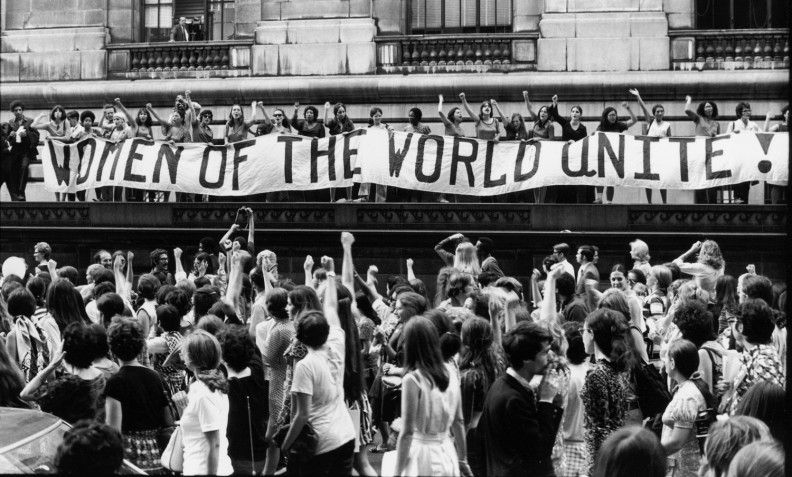How was the March 8 International Women’s Strike woven together?

That femicide occurred the day after the 31st National Women’s Meeting in Rosario (Argentina), in which 70,000 women participated and, in a closing march, occupied forty street blocks. The meeting only appeared in the press because it was repressed at the end. At the beginning of that same month, women in Poland convoked a national strike rejecting the changes that were being imposed in local legislation to further restrict access to legal abortion.
Following the October 19 Women’s Strike and the formation of alliances of women from different parts of the world, the call emerged for an International Women’s Strike on March 8.
The precursors to the massive demonstrations against femicides under the rallying cry Not One Less (#NiUnaMenos), which took place on June 3, 2015 and 2016 in Argentina, had demonstrated a strong mobilizing power. And over the last year, a network of coordination between different Latin American countries was already being woven.
The October 19 Strike was the first women’s strike in the history of Argentina and Latin America. A strike was called for one hour, in all possible spaces: workplaces, educational spaces, domestic spaces, neighborhood ones, etc. The following mobilization was truly enormous: more than 250,000 people in Buenos Aires and more marches all over the country (#NosotrasParamos). Latin America was rapidly connected through the strike call.
Using the tool of the strike allowed for highlighting the economic fabric of patriarchal violence. And it was also an enormous demonstration of power because we removed ourselves from the place of the victim to position ourselves as political subjects and producers of value. We complicated the category of women workers and made it clear that work is also domestic and informal, and includes forms of self-managed association. As the slogan Ni Una Menos had already been taken up in various Latin American countries, the October 19 mobilizations were quickly replicated, in connection with the Argentinean call and the demands of each country against patriarchal violence.
The organization of assemblies, acts, and mobilizations for November 25 (taking advantage of another appointment on the women’s calendar: the day for the elimination of violence against women) accelerated the work of transversal connection between many countries, exceeding the usual initiatives on that date.
A new geography was drawn going from from Ciudad Juárez to Moscow, from Guayaquil to Warsaw and Sao Paolo, from Rome to San Salvador de Jujuy. The local and global fabric produced a new type of internationalism that was seen in the networks and in the streets – new practice of feminist internationalism.
An initiative is being coordinated through Facebook – the Paro Internacional de Mujeres/International Women’s Strike (PIM) – by a group of women in Poland, who have been joined by activists from various countries in Europe and other regions of the world. Along with a website, the Facebook group is also circulating a petition to the United Nations and a manifesto.
On January 23, Ni Una Menos launched its own call, with different contents from the petition to the United Nations and the PIM manifesto. We understand that the manifesto has to be nourished based on concrete situations and struggles, and linked to the construction of a dynamic that demands systematic changes and combats the dominant neoliberal, neoconservative, racist, and patriarchal model. We believe that we are in a process of accumulation of a new type: where struggles resonate and work by gaining strength from intersectionality.
The Women’s March in the United States on January 21 is part of this cycle that demonstrates a new form of feminism: the overlapping movements of women, trans people, and migrants refuse to remain subjected to the empire of new forms of capitalist exploitation. Following that march, there is now a call from organizers to join the March 8 strike.
We are committed not only to virtual coordination, but also to patiently weaving a new fabric, body-to-body and in the streets. We open up dialogues and work every day in constructing networks with all the countries of Latin America and with other parts of the world.
On February 3, in an open and heterogeneous assembly, all the currents of the women’s movement in Argentina agreed upon a call to labor unions to support the women’s strike initiative. We appeal precisely to an interpellation of the question of work, and do so in a feminist key: we are not only talking about waged and formal workers, but also inscribing our critique, our demands, and our strike in a framework that fully challenges the precarization of our lives and the criminalization of our autonomy.
We believe that the multiplicity of calls for the March 8 International Women’s Strike becomes powerful when it highlights a lineage of popular struggles and the women’s movement in a new way, proposing here and now the world in which we want to live, and linking it and situating it with trajectories and struggles from each territory.
Translated by Liz Mason-Deese. Ni Una Menos Collective is a feminist collective against male violence, based in Argentina.